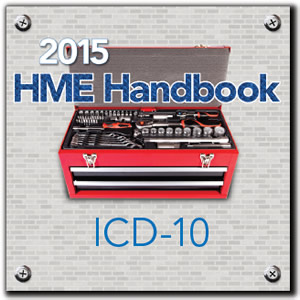2015 HME Handbook
How to Properly Prepare Your Organization for ICD-10
Your business must comply with the latest ICD revision by Oct. 1 if it wants to keep billing Medicare. Are you ready?

There’s a good chance you’ve heard about ICD-10, but you might not realize its significance. As the standard diagnostic tool for epidemiology, health management and clinical purposes, the World Health Organization’s ICD-10 is the 10th revision of the International Classification of Diseases. More to the point, by Oct. 1, your business must comply with the revision if it wants to keep billing Medicare.
ICD codes are the world standard for classifying diseases, injuries, health encounters and inpatient procedures in morbidity settings. ICD-10 marks the largest ICD revision ever adopted by the healthcare community. Although the ICD is under constant revision, ICD-10 has major modifications, taking the number of ICD-9 codes from 3,824 (procedure) and 14,025 (diagnosis) to 71,924 (procedure) and 69,823 (diagnosis).
The reason for Medicare’s move: The U.S. has been using ICD-9 since 1979, and it is no longer clinically accurate, with limited data about patients’ medical conditions and hospital inpatient procedures. The new coding system should enable more detailed patient history coding to help better coordinate a patient’s care across providers and over time. ICD-10 also aims to improve quality measurement and reporting; facilitate the detection and prevention of fraud, waste, and abuse; and improve accuracy of reimbursement for medical services. According to CMS, ICD-10 helps improve patient outcomes, provide detailed data, improve quality tracking and reporting, and survey public health issues.
And the world seems to agree. Since the World Health Organization completed work on ICD-10 in 1992, countries have been adopting the standard with 110 nations using the unmodified the system, and 25 countries using a modified version of ICD-10. If anything, the United States is late to the party (which is understandable given the size and complexity of our health infrastructure).
So, the U.S. Department of Health and Human Services (HHS) issued a rule finalizing Oct. 1, 2015, as the new compliance date for healthcare providers, health plans, and health care clearinghouses to transition to ICD-10. What should a provider do to ensure the entire organization complies.
Start With Your Software Vendor
Software is the main tool for implementing ICD-10 preparation. In fact, software vendors have been so out in front of ICD-10 that in many respects they are leading the industry’s push for complying with ICD-10. Many software vendors are trying to help providers by providing tools to match ICD-9 to ICD-10 codes and allow for a smooth and automated transition, healthcare providers can be assured they are addressing the movement from the old code set to the new one in an accurate way. Contact your software vendor prior to building your action plan to ensure that your strategies are in line with that of the software vendor. Find out if the software can transfer ICD-9 codes to ICD-10; know what level of manual work will be required to transition between the two; will the software provide tools for inspecting claims to ensure they are using the right codes; and know if the software can help the provider test prior to Oct. 1 in order to ensure the transition has been effective.
Bring the Team up to Speed
Make sure the team is fully aware of the transition and review with staff information about the ICD-10 code set in order to gain a basic understanding of the changes from ICD-9 to ICD-10. This understanding will be needed in order to conduct an impact analysis and determine how the move to ICD-10 will affect their business practices and systems. They also should complete an inventory of all your systems, electronic and manual, that use the ICD-9 codes.
Coding Staff Are Key
In particular, providers must ensure that their training efforts train coding staff on the ICD-10 code set prior to the compliance date. A good exercise it to have coding staff should practice internally using the ICD-10 codes on sample claims, such as current claims, prior to the compliance date. Also start by practicing with the most common diagnoses reported. Clinical staff must also receive training on ICD-10, although it does not need to be at the same detail as training for the coding staff.
Work with Referrals and Payors
Use your software to generate a report of your patients, grouped by physician, where there is more than one possibility of a corresponding ICD-10 code. Then contact those physician and update the patient records accordingly. Then, methodically convert each patient to become ICD-10 ready and monitor claim submissions after October to ensure a smooth adoption of ICD-10 for those patients, so as not to disrupt cash flow by having a claim rejected. Similarly, work with payors and billing services to ensure that your efforts will reflect the ICD-10 transition efforts they are engaged in. See if those partners will need your business to engage in any testing exercises so that your businesses work in concert.
Points to Take Away:
- In the works since 1988, ICD-10 is a massive expansion of the World Health Organization’s International Classification of Diseases.
- While 135 counties have been adopting ICD-10 since the mid 1990s, the U.S. Medicare program has set its mandatory compliance date for Oct. 1 of this year.
- Providers must comply by that date in order to keep billing Medicare.
- Software will be a key tool to help providers transition their businesses to ICD-10, and software vendors have been leading the industry’s charge to the transition.
- In addition, providers will want to train their entire teams, especially any staff related to claims coding.
- In addition, providers will want to coordinate with their referral partners and payors.
Learn More:
This article originally appeared in the June 2015 issue of HME Business.